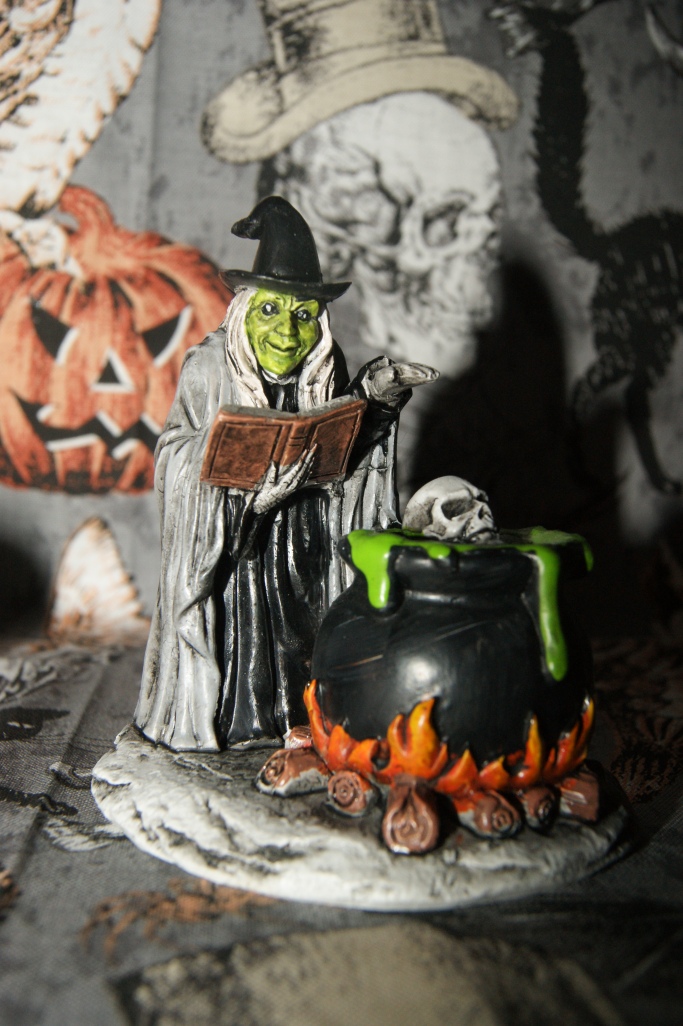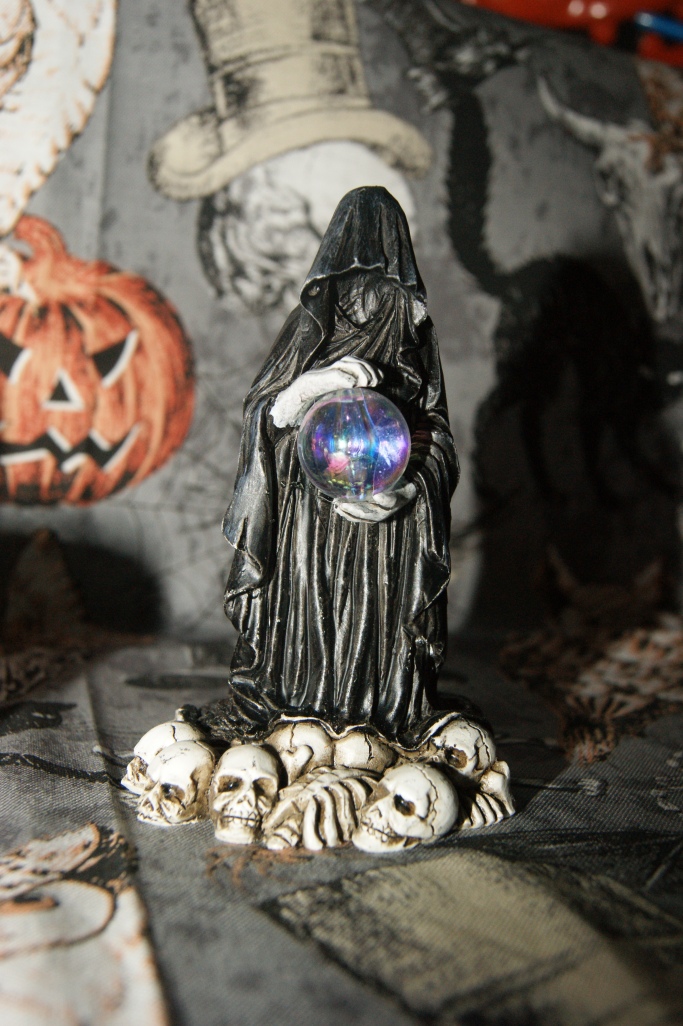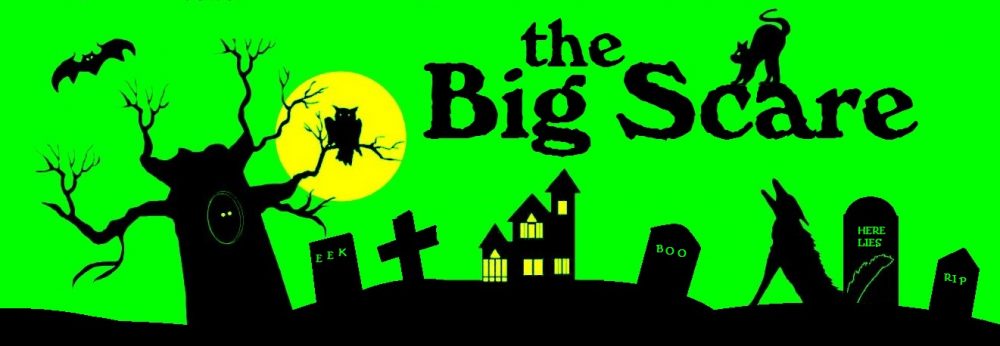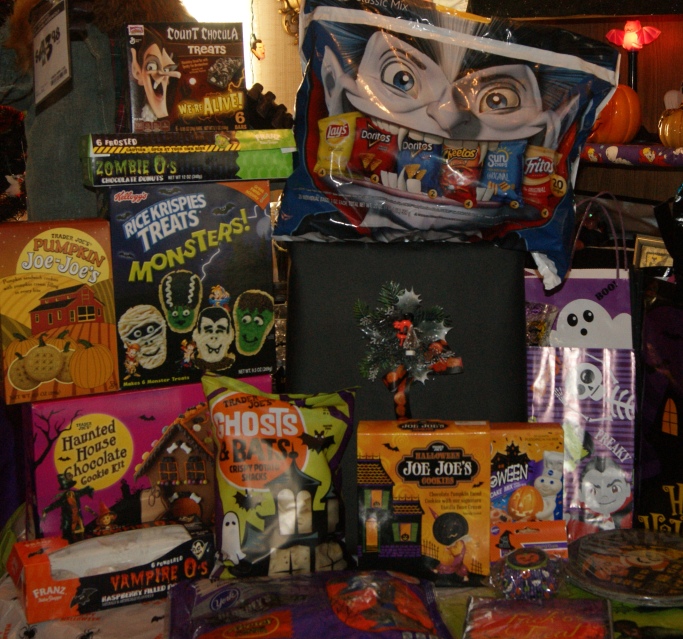Overview:
 Before the late 1980s, Halloween decorating was mostly comprised of putting up ceramic jack-o’-lanterns, cardboard cutouts of ghosts, and the occasional lighted blow mold. But, in 1986, one company developed an idea that forever changed the way haunters decorated their homes, for that was the year when Telco Creations introduced a revolutionary concept to the witching season: animation. Nowadays, Americans take for granted that they can walk into any store to purchase an animatronic figure to “frighten up” their All Hallows’ displays. Before Telco, that would have been impossible. Telco Creations was renowned for its innovative Christmas decorations, and it only seemed an appropriate next step to tackle Halloween. Thus, the Original Telco Motion-ettes of Halloween were born: the Witch, the Ghost, and the Scarecrow. The line immediately expanded to include the Monster and the Vampire characters, as well as the Skeleton in the top hat. Each tabletop figure stood 24” tall, sized to be reminiscent of the motorized holiday window displays for which department stores had always been known. They featured head and arm movement, as well as illumination, and were powered by electricity.
Before the late 1980s, Halloween decorating was mostly comprised of putting up ceramic jack-o’-lanterns, cardboard cutouts of ghosts, and the occasional lighted blow mold. But, in 1986, one company developed an idea that forever changed the way haunters decorated their homes, for that was the year when Telco Creations introduced a revolutionary concept to the witching season: animation. Nowadays, Americans take for granted that they can walk into any store to purchase an animatronic figure to “frighten up” their All Hallows’ displays. Before Telco, that would have been impossible. Telco Creations was renowned for its innovative Christmas decorations, and it only seemed an appropriate next step to tackle Halloween. Thus, the Original Telco Motion-ettes of Halloween were born: the Witch, the Ghost, and the Scarecrow. The line immediately expanded to include the Monster and the Vampire characters, as well as the Skeleton in the top hat. Each tabletop figure stood 24” tall, sized to be reminiscent of the motorized holiday window displays for which department stores had always been known. They featured head and arm movement, as well as illumination, and were powered by electricity.

By 1987, Telco Creations had introduced its line-up of groovy ghouls nationwide in retailers like Woolworth and Kmart. By 1988, the catalog was even more expansive, even including smaller (18″), battery-operated versions of the figures, each of which had lighted eyes and a spooky sounds. (An intermediate line of figures followed.) The characteristics of the larger Motion-ettes morphed over time to include additional features like lighted heads and “life-like” audio. In 1992, Telco joined forces with Universal Studios to create officially licensed monster Motion-ettes. After this release, the larger, electric figures were phased out. However, the smaller, battery-operated Halloween figures remained in stores through the end of the century. This guide is intended to help you understand the development of the Motion-ette line and identify certain figures you may have seen. If your question isn’t answered here, it may be addressed in our Telco Halloween Motion-ettes FAQ. You may also be interested in our Fair Market Value Guide based upon our ten-year observations.
Editor’s Note: The images on this page are archival images, many of which are over 25 years old. In some cases, there are obvious defects in our particular copies of the images. The Big Scare has done its best to present the best quality Telco stock, promotional, and catalog images for your reference, so as to provide you with the most accurate depiction of the products. All information and images on this page are for educational purposes.
The Original Motion-ettes of Halloween
The first Telco Halloween figures are uniquely different from those that followed. While all early Telco figures featured electric power, motion, and an accessory (usually illuminated), the first wave included figures with single-arm motion as opposed to the more common double-arm movement. The figures were activated by a red button on the base, as opposed to the more common cord rotary switch. Furthermore, the figures had a glossier, shinier finish.

Witch (Original Telco Stock Image 1986/1987)

Monster (Original Telco Stock Image 1987)

Ghost (Original Telco Stock Image 1986/1987)

Scarecrow (Original Telco Stock Image 1986/1987)

Vampire (Original Telco Stock Image 1987)
Their accessories were also less standardized and, in the case of the Monster, more elegant. Unlike later versions, the first Monster came equipped with a metal lantern. Other differences include a more Karloffian head-sculpt and a lighter costume. The other figure that experienced a major overhaul from its initial incarnation was the Ghost. The first release looked like the classic “bed sheet” ghoul. Later on, this spook received a glowing jack-o’-lantern head. Its lighted skull accessory was also replaced with a cat (which was illuminated in some figures and not in others). The Scarecrow later received a set of plastic arms and a sculpted head, though the cloth version returned for a brief stint in 1989. The Skeleton only experienced a change of accessories. For the most part, the design of the original Witch remained unchanged throughout the entire run of the line, as did that of the original Vampire. While materials changed and additional features were added, these two were the most steadfast figures in the whole series, though it should be noted that the Vampire was given a range of accessories in addition to the traditional skull and later received a “glowing head.”
Awful Accessories
The Telco series of animated figures was unique in the fact that its figures had a variety of accessories. The most commonly used accessories were skulls, pumpkins, plastic lanterns, and cats. However, broomsticks, canes, pitchforks, and crows/ravens were also added to certain figures. The most unique accessories would have to be the Witch’s crystal ball and the hard plastic bats and cobras (snakes). The bat accessories were actually modeled after Telco’s own animated bat figure.
Chilling Changes
 By the time 1988 rolled around, Telco had given most of its original characters makeovers, and it added new designs to the mix. The Vampire Bat, “Wolfman” (Werewolf), Gorilla, and Devil all made their debuts in the 1988 catalog. Each of these figures included a feature new to 24″ Motion-ettes: lighted eyes. Depending on the character, the eyes either glowed red or orange. In addition, Kmart carried an exclusive Witch (with an alternate head sculpt) and the Phantom of the Opera that year. Both were distributed to other retailers the following year. 1988 was also the year that Telco introduced a feature that would later become a staple of the Halloween line: glowing heads. The first figure to feature a fully illuminated head was the newly-designed Ghost Motion-ette. His plastic jack-o’-lantern head turned side to side, while glowing bright orange.
By the time 1988 rolled around, Telco had given most of its original characters makeovers, and it added new designs to the mix. The Vampire Bat, “Wolfman” (Werewolf), Gorilla, and Devil all made their debuts in the 1988 catalog. Each of these figures included a feature new to 24″ Motion-ettes: lighted eyes. Depending on the character, the eyes either glowed red or orange. In addition, Kmart carried an exclusive Witch (with an alternate head sculpt) and the Phantom of the Opera that year. Both were distributed to other retailers the following year. 1988 was also the year that Telco introduced a feature that would later become a staple of the Halloween line: glowing heads. The first figure to feature a fully illuminated head was the newly-designed Ghost Motion-ette. His plastic jack-o’-lantern head turned side to side, while glowing bright orange.

Second Edition Ghost (1988 Telco Stock Image)

Second Edition Vampire (1988 Telco Stock Image)

Vampire Bat (1988 Telco Catalog Image)

Second Edition Monster (1988 Telco Stock Image)

Wolfman, Gorilla, and Devil (1988 Telco Catalog Images)

“Witch Casting Spell” (1988 Telco Catalog Image)

“Haunting Skeleton” (1988 Telco Catalog Image)

Alternate Witch (1988 Telco Stock Image)

Phantom of the Opera (1988 Telco Stock Image)
From Bug Eyes to Glowing Heads: Telco Grows Up
By 1989, Telco continued to expand its character offerings, introducing new characters such as the “Flying Wicked Witch” and a Grim Reaper. And while the original six characters remained unaltered from the previous year’s makeover, the 1988 additions each received a new treatment.
The g lo
lo wing eyes on the Devil, Wolfman, and Vampire Bat were all replaced with sculpted eyes, though the resulting “bug eyes” made the characters look “crazed” and “mad,” making these versions less popular than the former glowing-eyed figures and far more rare on the secondary market. While the glowing-eyed beasts can be purchased rather easily, the bug-eyed monsters don’t show up that often, and, when they do, they generally sell for 1.5 to 2 times the amount of their lighted-eye counterparts. The Devil and Wolfman later received glowing heads.
wing eyes on the Devil, Wolfman, and Vampire Bat were all replaced with sculpted eyes, though the resulting “bug eyes” made the characters look “crazed” and “mad,” making these versions less popular than the former glowing-eyed figures and far more rare on the secondary market. While the glowing-eyed beasts can be purchased rather easily, the bug-eyed monsters don’t show up that often, and, when they do, they generally sell for 1.5 to 2 times the amount of their lighted-eye counterparts. The Devil and Wolfman later received glowing heads.
In fact, in 1990, all of the Halloween Motion-ettes debuted with fully illuminated heads. To make the new technology work, most of the figures’ heads were re-cast in lighter-colored plastic. The Vampire and the Phantom of the Opera were now extremely pale, the Monster was now molded in yellow, and the Wolfman became green. (This green “Wolfman” was later renamed the “Beast Man.”) The Witch saw no change, which made the feature rather ineffective. An alternate Witch also received the “glow” treatment. Additionally, a new character was added to the catalog, this one based on the 1925 Universal picture, The Phantom of the Opera. The figure was named “Red Death,” after the sequence in the film and the character in the Edgar Allan Poe short story. By 1991, Telco streamlined its output, reducing the Halloween offerings to the glowing versions of the Witch, Vampire, Monster, and the Grim Reaper character (which now adopted the “Skeleton” moniker). In its final effort to innovate, Telco added “life-like” sounds to its 24″ line. The audio (usually cackling, laughing, or moaning) could be controlled by a switch on the base of the figures.

Glow-Head Vampire (1990 Telco Stock Image)

Glow-Head Skeleton (1990 Telco Stock Image)

Glow-Head Witch (1990 Telco Stock Image)

Glow-Head Phantom of the Opera (1990 Telco Stock Image)

Glow-Head Monster (1990 Telco Stock Image)

Flying Witch (1989 Telco Stock Image)
Inspirations and Imitations
The muse behind the designs of the Halloween figures has always been a bit of a mystery, but it is clear that Telco drew inspiration from images of the classic monsters and assorted Halloween toys that were available at the time. For example, comparing the head sculpts of the Telco Motion-ettes to 1980s Halloween masks is an interesting exercise. The Devil sculpt has a lot in common with the “Be Something Studios” Lucifer mask from 1980. The argument could be made for other characters as well (albeit with different mask companies). But no one will ever really know if Halloween masks were the references used by the Telco team. What is clear, though, is that designs of the Monster, Vampire, and Phantom all appear to be based on the characters portrayed by Boris Karloff, Christopher Lee, and Lon Chaney, Sr. respectively, making these innovative figures the first animated Halloween tributes to Horror films.
Because Telco’s idea was so successful, other companies immediately started production on their own lines of animated Halloween figures, all with the same basic features, many with eerily similar character designs, some with totally unique takes. Competitors included Witchtime, Topstone, Rennoc (now Santa’s Best), EPI, and, of course, Gemmy — the current powerhouse in Halloween animation. Additional companies joined the holiday animation war, but they went as quickly as they came.
Something Different
By 1991, the market was so saturated with Halloween animation, Telco decided that it had to do something different. The following year, it joined forces with Universal City Studios to create an official line of Motion-ettes modeled after the Universal Studios Monsters. These Motion-ettes were the first ever animated Halloween figures to be licensed by a movie studio, thus inspiring a trend that would forever change Halloween decorating.
 The initial release of the Universal Monsters included the four main characters: Dracula, Frankenstein’s Monster, the Wolf Man, and the Creature from the Black Lagoon. All of the characters received official head sculpts and costumes. They were produced in both electric 21″ (instead of the regular 24″) and battery-operated 18″ formats (There were also 16″ variants). Unlike their generic predecessors, they did not have lighted accessories, but they did include sound. They were widely available at Wal-Mart, Kroger, and Meijer stores, as well as smaller retailers. After the success of the first line, the Bride of Frankenstein and the Mummy were added; though, by this point, Telco’s focus had shifted to the more economical battery-operated 18″ line, making the last two difficult to come by in the larger size. The 21″ version of the Mummy is the rarest of all Motion-ette figures, though he has surfaced on the secondary market. It should also be noted that there were two versions of the Frankenstein Monster produced. The first release came with a bright green paint application, while the second was released in a pasty, grayish green color.
The initial release of the Universal Monsters included the four main characters: Dracula, Frankenstein’s Monster, the Wolf Man, and the Creature from the Black Lagoon. All of the characters received official head sculpts and costumes. They were produced in both electric 21″ (instead of the regular 24″) and battery-operated 18″ formats (There were also 16″ variants). Unlike their generic predecessors, they did not have lighted accessories, but they did include sound. They were widely available at Wal-Mart, Kroger, and Meijer stores, as well as smaller retailers. After the success of the first line, the Bride of Frankenstein and the Mummy were added; though, by this point, Telco’s focus had shifted to the more economical battery-operated 18″ line, making the last two difficult to come by in the larger size. The 21″ version of the Mummy is the rarest of all Motion-ette figures, though he has surfaced on the secondary market. It should also be noted that there were two versions of the Frankenstein Monster produced. The first release came with a bright green paint application, while the second was released in a pasty, grayish green color.

Creature from the Black Lagoon (1992 Telco Promotional Image)

“Frankenstein” (1992 Telco Stock Image)

Dracula (1992 Telco Promotional Image)

Wolf Man (1992 Telco Stock Image)
Moving Forward
With so much competition, Telco’s decision to focus on its smaller, battery-operated line was a smart one and kept the Halloween figures in stores through the end of the 1990s. For the most part, the character offerings remained limited. After the Universal line, Telco returned to the traditional generic characters. The 18″ line-up included the Vampire, the Monster, the Skeleton, and two versions of the Witch. (To read more about the small line and the intermediate line, click here.) Telco also released a few unique takes on these characters during this time: a Witch rising from a cauldron and a Grim Reaper rising from a chair. The latter featured some of the most technologically advanced animation in Halloween decorating to that point. It also featured a unique soundtrack with spoken dialogue and sound effects, a huge improvement over the previous “life-like” sound. Telco folded shortly after the start of the new century due to factory problems, but its legacy lives on and today’s Halloween animatronic manufacturers owe Telco everything for paving the way for their success.

Animated Witch in a Cauldron Promotional Art

18″ Witch (Alternate Sculpt) Stock Art

The (Rising) Grim Reaper Promotional Art
Have a question that wasn’t addressed in this guide? Check out our Telco Halloween Motion-ettes FAQ!































 Before the late 1980s, Halloween decorating was mostly comprised of putting up ceramic jack-o’-lanterns, cardboard cutouts of ghosts, and the occasional lighted blow mold. But, in 1986, one company developed an idea that forever changed the way haunters decorated their homes, for that was the year when Telco Creations introduced a revolutionary concept to the witching season:
Before the late 1980s, Halloween decorating was mostly comprised of putting up ceramic jack-o’-lanterns, cardboard cutouts of ghosts, and the occasional lighted blow mold. But, in 1986, one company developed an idea that forever changed the way haunters decorated their homes, for that was the year when Telco Creations introduced a revolutionary concept to the witching season: 





 By the time 1988 rolled around, Telco had given most of its original characters makeovers, and it added new designs to the mix. The Vampire Bat, “Wolfman” (Werewolf), Gorilla, and Devil all made their debuts in the 1988 catalog. Each of these figures included a feature new to 24″ Motion-ettes: lighted eyes. Depending on the character, the eyes either glowed red or orange. In addition, Kmart carried an exclusive Witch (with an alternate head sculpt) and the Phantom of the Opera that year. Both were distributed to other retailers the following year. 1988 was also the year that Telco introduced a feature that would later become a staple of the Halloween line: glowing heads. The first figure to feature a fully illuminated head was the newly-designed Ghost Motion-ette. His plastic jack-o’-lantern head turned side to side, while glowing bright orange.
By the time 1988 rolled around, Telco had given most of its original characters makeovers, and it added new designs to the mix. The Vampire Bat, “Wolfman” (Werewolf), Gorilla, and Devil all made their debuts in the 1988 catalog. Each of these figures included a feature new to 24″ Motion-ettes: lighted eyes. Depending on the character, the eyes either glowed red or orange. In addition, Kmart carried an exclusive Witch (with an alternate head sculpt) and the Phantom of the Opera that year. Both were distributed to other retailers the following year. 1988 was also the year that Telco introduced a feature that would later become a staple of the Halloween line: glowing heads. The first figure to feature a fully illuminated head was the newly-designed Ghost Motion-ette. His plastic jack-o’-lantern head turned side to side, while glowing bright orange.








 lo
lo wing eyes on the Devil, Wolfman, and Vampire Bat were all replaced with sculpted eyes, though the resulting “bug eyes” made the characters look “crazed” and “mad,” making these versions less popular than the former glowing-eyed figures and far more rare on the secondary market. While the glowing-eyed beasts can be purchased rather easily, the bug-eyed monsters don’t show up that often, and, when they do, they generally sell for 1.5 to 2 times the amount of their lighted-eye counterparts. The Devil and Wolfman later received glowing heads.
wing eyes on the Devil, Wolfman, and Vampire Bat were all replaced with sculpted eyes, though the resulting “bug eyes” made the characters look “crazed” and “mad,” making these versions less popular than the former glowing-eyed figures and far more rare on the secondary market. While the glowing-eyed beasts can be purchased rather easily, the bug-eyed monsters don’t show up that often, and, when they do, they generally sell for 1.5 to 2 times the amount of their lighted-eye counterparts. The Devil and Wolfman later received glowing heads.




















